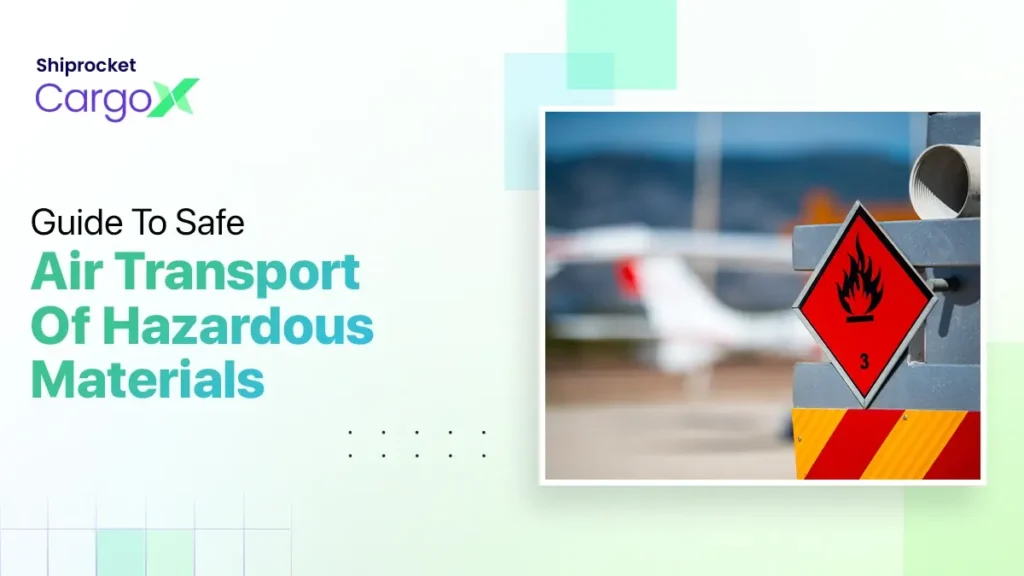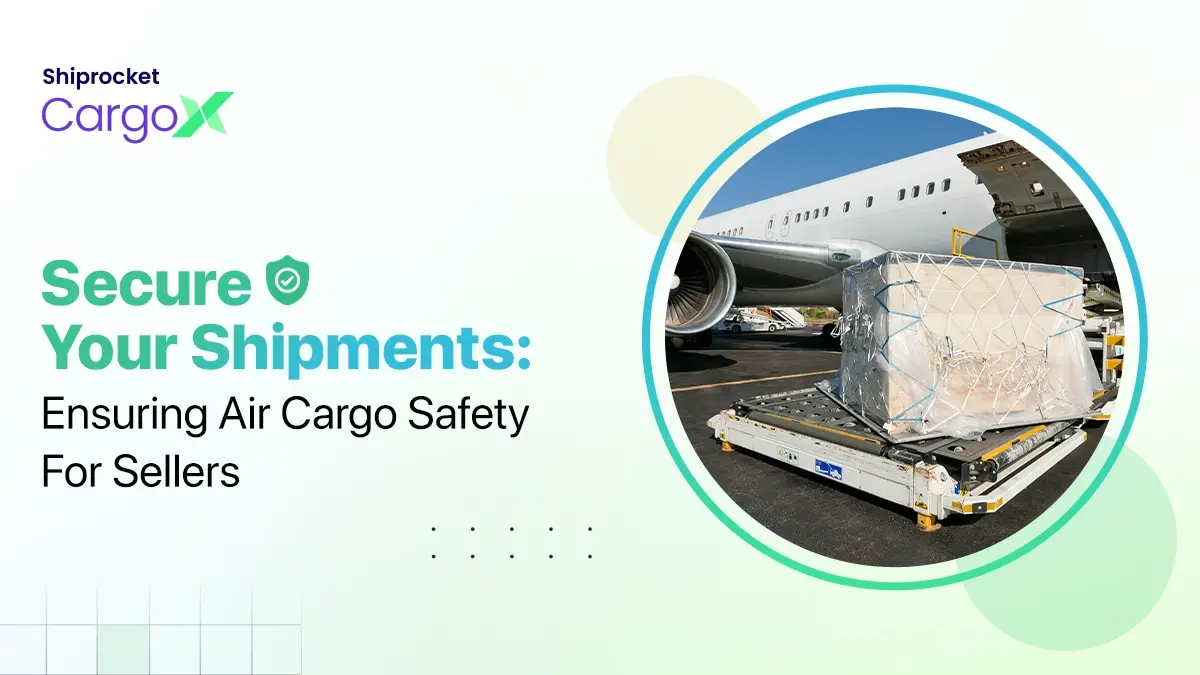Safe Air Transport: Essential Ways to Ship Dangerous Goods
Over 1.25 million shipments of hazardous materials are transported every year in air cargo. Industry experts predict the growth of air cargo to go up by 4.9% annually for the next five years, significantly increasing the volume of dangerous goods. Given the quantity of dangerous materials carried through the air route, it’s imperative to have strict safety regulations in place. To make policies regarding the flying of hazardous air cargo, the International Air Transport Association (IATA) evaluates the risks involved and collaborates with the International Civil Aviation Organization (ICAO) to draw, update and refine these regulations. It ensures that stakeholders have access to the latest guidelines for the safe handling and shipment of dangerous items.
Understanding what items are included in the dangerous goods category is crucial before shipping them. The manual by IATA Dangerous Goods Regulations (DGR) defines dangerous goods (also referred to as hazardous materials or hazmat) as substances that pose potential risks to health, safety, property, or the environment. You’ll find these items listed in the IATA DGR. This article will help you get a deeper insight into the intricacies of flying dangerous goods.

Some Common Dangerous Goods
Mostly, the shippers who have profound knowledge and expertise in hazmat transportation manage the majority of hazardous shipments for the consignor. A list of hazardous goods transported via air includes the following:
- Aerosols
- Lithium batteries
- Infectious agents
- Fireworks
- Dry ice
- Engines and machinery powered by gasoline
- Lighters
- Paint
International Air Transport Association (IATA) Regulations
IATA’s Dangerous Goods Regulations offer a user-friendly manual that synchronises with the safety transport guidelines for hazardous materials laid down by the International Civil Aviation Organization (ICAO). Moreover, these regulations comprise the United Nations’ classification of substances under dangerous goods classes and a clear definition of their eligibility and requirements for air shipment. By merging the safety standards of both ICAO and the UN, IATA streamlines the protocols for dangerous goods shipping, which guarantees the implementation of the most stringent safety measures.
International Civil Aviation Organization (ICAO) Standards
ICAO (International Civil Aviation Organization)is the body responsible for laying down the global standards for the secure transport of dangerous goods by air. These technical instructions are the most potent way to make air transport safe and secure and alleviate the risk to passengers, aircraft, crew, and the environment. The ICAO standards also act as a foundation for national and international regulations governing the air transport of dangerous goods. It also includes the directives adopted by the International Air Transport Association (IATA) for its member airlines. Here are some of the standards set by ICAO for handling dangerous goods in air transportation:
Dangerous goods classification: ICAO categorises dangerous goods into 9 different classes, based on the kind of risk they present. Each class of goods requires its specific packing, labelling, and marking before being shipped. Some examples of these classes are explosives, gases, flammable liquids, and infectious substances.
Packaging requirements for hazardous goods: For obvious reasons, the shipment packaging is supposed to align with the testing standards set by the ICAO. These standards come with a set of instructions to contain and secure the above-mentioned dangerous goods throughout the transportation process. This especially helps as these goods often have to face changes in temperature, pressure, and sometimes even intense movement during their journeys.
Marking and labelling: There is a specific process for handling each class of dangerous goods, and therefore marking and labelling play a very important role. The marking not only conveys the class of dangerous goods, but they also contain symbols that convey their respective hazards.
Documentation of dangerous goods: Shippers must accurately fill in every detail to complete the documentation for each shipment. This includes a shipper’s Declaration for Dangerous Goods, which details the contents, class, and quantity of the dangerous goods being transported.
Handling and stowage instructions: A lot can go wrong with these dangerous goods, especially during a long journey by air. The ICAO standards have set out guidelines for handling and stowage as well. Special focus is given to the segregation rules as some of the incompatible dangerous goods if put together can create disastrous reactions.
Training personnel: To enforce the safe handling of these goods and ensure the instructions are followed to their absolute best, ICAO mandates proper training of those handling shipments. All the end-to-end personnel involved in the transportation process, like the packers, shippers, handlers, and flight crew are trained in the regulations and safe handling procedure of dangerous goods.
Emergency response prep: Despite the best training and preparation, disasters can still occur. Therefore, the carriers are also required to be well prepared with emergency response protocols, in case any incidents with these dangerous goods occur.
State and operator variations: ICAO sets the standards and at the same time they also recognise that these standards may vary for different countries and carriers. Therefore, it makes room for variations as long as the minimum safety regulations are met and the variations only add to the safety.
Extra security provisions: Dangerous goods also bring with them the danger of misuse and unlawful interference. To minimise this, the ICAO also has provisions for security screening and oversight of shipment.
Preparing for Transport
Shippers need to prepare materials correctly and in compliance with the regulations set for transporting dangerous goods across destinations. You can begin this process by accurately identifying the hazardous material, followed by using robust packaging that is capable of enduring the stresses of loading and transportation. Other relevant features that your packaging must have include the ability to prevent any damage or leakage and shield the contents from extreme pressure and temperature fluctuations during transit.
Moreover, you need to accurately mark and label each package, along with specific handling instructions and its hazard classification.
Shippers need to know that air transport only allows certain types of hazardous materials in freight containers or ULDs. You have to adhere to the guidelines mentioned in the IATA Dangerous Goods Regulations (DGR).
Safety Measures During Transportation
IATA diligently guards all the people involved in handling the shipments, like the personnel, passengers, and aircraft, in this transportation process. This body continuously updates and adapts its regulations and practices to meet the ever-evolving needs, while ensuring that the transport of dangerous goods through air is safe and efficient.
So, what can you do to enhance the safety of the transportation process? The strategies you see below will help you achieve the same:
1. Complying with up-to-date regulations
The first and foremost thing to ensure the safety, swiftness, and cost-effective shipment of dangerous goods is compliance with the latest set of regulations. When you stay updated with these regulations, it not only streamlines the shipping process but also saves you from the potential financial and logistical setbacks related to non-compliance.
Your shipments may get potentially detained, refused, or delayed, if you neglect or miss out on following any of the updated guidelines regarding the shipping of dangerous goods. Moreover, non-compliance may attract substantial fines. In certain jurisdictions, you may even face legal action from regulatory bodies for the unauthorised transport of hazardous materials.
2. Train for it
To prevent the ship from a possible wreck caused by the carrying of dangerous goods, shippers need to undergo intensive training in handling these types of goods and pass some relevant tests. This training can gear you up to perform your duties in accordance and compliance with regulatory standards.
3. Take accreditation for your team
Getting a Competency-based Training and Assessment (CBTA) accreditation puts a stamp on your organisation’s training programmes and assures that these programs align with the IATA Dangerous Goods Regulations. So, technically this accreditation emphasises a competency-based approach to training, which includes:
- Customising and suiting training to specific job functions
- Promoting ongoing learning and improvement
- Focusing on intensive learning instead of mere tests that you need to pass
- Bringing together the necessary knowledge, skills, and attitudes to perform like a professional
- Making your safety management systems (SMS) application better than before
- Reinforcing the availability of skilled and competent trainers
4. Digitising your operations
Open your current model to digital operations to improve the safety of shipping dangerous items by air. Digitisation brings in modernised operations, slashes some costs, and also cuts safety risks.
But the catch is to factor in things like proper packaging and accurate documentation to maintain the safety of these goods. Furthermore, go ahead and prepare the Shipper’s Declaration of Dangerous Goods (DGD), which holds a prominent place in this process. It contains important details for the entire shipping journey.
Moreover, digitising the DGD process will also minimise the risk of human error, which is a critical consideration given the high volume of shipments processed daily. You must use this approach to streamline operations, which promotes safer and more efficient handling of dangerous goods.
Training for Personnel Involved
There is specialised training tailored to specific roles in the shipping industry. Some of the professionals who are trained to handle the shipping of dangerous goods are:
- Personnel dedicated to accepting dangerous goods consignments
- Transporters of infectious substances
- Shippers and packers
- Security screening staff
- Loadmasters and load planners
- Training instructors
Sources for Training
Be particular about taking comprehensive training to fully adhere to the regulations specified in the IATA Dangerous Goods Regulations (DGR). IATA’s training programmes fit perfectly with these regulations, enabling the smooth and safe transport of dangerous goods by air.
To go further into the details of such training programmes, you can explore options like Dangerous Goods Digital Training and learn about the pressing need for such training to transport these goods safely. Additionally, many other resources are available to guide you in obtaining a dangerous goods certification meeting IATA’s regulatory standards.
Emerging Technologies in Dangerous Goods Transportation
Digitalising the shipping process for handling dangerous goods has become a cakewalk with IATA’s introduction of the DG AutoCheck. The innovative digital tool progressively pushes airlines, ground handlers, and freight forwarders to automatically verify the compliance of shipments with the IATA Dangerous Goods Regulations. DG AutoCheck, therefore, is a magnificent tool to streamline the acceptance process and enhance safety.
DG AutoCheck puts the mandatory acceptance checks stipulated by international regulations in a row while processing both electronic and scanned paper Dangerous Goods Declarations (DGDs). It diligently compares every entry against the IATA regulations and propels thorough compliance. The system cleverly prevents progress to subsequent sections until you resolve all the queries in the current section, such as completing document verification before proceeding to package inspections.
In case the system stumbles upon a few regulatory discrepancies or areas needing manual inspection, it alerts the user for additional checks. DG AutoCheck also brings in features like exporting dangerous goods data for creating notifications to the pilot-in-command (NOTOC) and generating detailed acceptance and rejection reports for managerial review.
DG helps airlines and ground handlers with its ability to aid in the precise and efficient acceptance of dangerous goods shipments. Along with these two beneficiaries, It allows freight forwarders to conduct preliminary checks before submitting documents and parcels to airlines. This “pre-acceptance check” process diffuses the risk of shipment rejection and avoids potential delays and fines.
Conclusion
The way to swing through this tricky transportation process of dangerous goods is to adopt a comprehensive strategy. The strategy encompasses many aspects from choosing the appropriate packaging for dangerous goods to ensuring that the labels and markings meet regulatory standards. It also involves engaging in preparatory steps to bring about total compliance. The tools that help you touch base with this compliance include resources like IATA’s dangerous goods training courses, Competency-based Training and Assessment (CBTA) accreditation, DG AutoCheck, and adherence to the IATA Dangerous Goods Regulations. These elements are collectively beneficial to establishing and maintaining high safety standards in the shipment process.You can entrust logistics services like Shiprocket’s CargoX for transporting any of your heavy and bulk consignments across borders. However, for shipping dangerous goods, you should find a freight service that specialises in moving such items with care following IATA guidelines.
IATA works to refresh these regulations annually due to the dynamic nature of safety protocols and the evolving landscape of air transport. This frequent update cycle helps with the integration of the most current safety information and procedural adjustments. It contrasts with the ICAO’s biennial update schedule and brings IATA’s commitment to providing stakeholders with the latest guidance to light. This yearly update is inevitable for not only aligning with global standards but also for accommodating more stringent national and airline-specific requirements. They ensure comprehensive and up-to-date compliance across the industry.
The United Nations segregates hazardous goods into nine different classes to ensure that they communicate the specific hazards they present throughout the transportation process. Here’s a lineup of the classes of dangerous goods:
Class 1: Explosives
Class 2: Gases
Class 3: Flammable Liquids
Class 4: Flammable Solids
Class 5: Oxidising Substances and Organic Peroxides
Class 6: Toxic and Infectious Substances
Class 7: Radioactive Material
Class 8: Corrosives
Class 9: Miscellaneous Dangerous Articles and Substances, including substances that are hazardous to the environment
IATA is working hard to mandate dangerous goods training for everyone in the supply chain involved in the preparation, offering, acceptance, and handling of dangerous goods, owing to the importance of safety in aviation. It encourages people to take retraining every two years to ensure all parties stay informed on the latest regulations and safe handling practices. The sources that IATA provides to facilitate access to this essential training are courses and annual manuals, which keep stakeholders always equipped with the most current information and guidelines.




